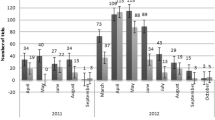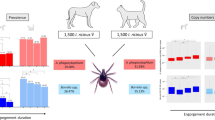Abstract
A total of 305 Ixodes ricinus ticks collected from three areas of Thuringia in central Germany were investigated for infection with Borrelia burgdorferi sensu lato species and Anaplasma phagocytophila. Overall, 11.1% were infected with Borrelia burgdorferi and 2.3% with Anaplasma phagocytophila. Adult ticks showed a significantly higher rate of infection with both borreliae and Anaplasma phagocytophila. Borrelia garinii (55.9%) was detected most frequently, followed by Borrelia burgdorferi sensu stricto (32.4%), Borrelia afzelii (17.6%), and Borrelia valaisiana (5.9%). Four ticks had dual infection with Borrelia garinii and Borrelia burgdorferi sensu stricto. Two of the Borrelia-positive ticks were coinfected with Anaplasma phagocytophila.
Similar content being viewed by others
References
Saint Girons I, Gern L, Gray JS, Korenberg E, Nuttall PA, Rijpkema SGT, Schönberg A, Stanek G, Postic D (1998) Identification of Borrelia burgdorferi sensu lato species in Europe. Zentralbl Bakteriol 287:190–195
Rijpkema SGT, Molkenboer MJCH, Schouls LM, Jongejan F, Schellekens JFP (1995) Simultaneous detection and genotyping of three genomic groups of Borrelia burgdorferi sensu lato in Dutch Ixodes ricinus ticks by characterization of the amplified intergenic spacer region between 5S and 23S rRNA genes. J Clin Microbiol 33:3091–3095
Wang G, van Dam AP, Schwartz I, Dankert J (1999) Molecular typing of Borrelia burgdorferi sensu lato: taxonomic, epidemiological, and clinical implications. Clin Microbiol Rev 12:633–653
Chen SM, Dumler JS, Bakken JS, Walker DH (1994) Identification of a granulocytotropic Ehrlichia species as the etiologic agent of human disease. J Clin Microbiol 32:589–595
Dumler JS, Barbet AF, Bekker CPJ, Dasch GA, Palmer GH, Ray SC, Rikihisa Y, Rurangirwa FR (2001) Reorganization of genera in the families Rickettsiaceae and Anaplasmataceae in the order Rickettsiales: unification of some species of Ehrlichia with Anaplasma, Cowdria with Ehrlichia and Ehrlichia with Neorickettsia, descriptions of six new species combinations and designation of Ehrlichia equi and "HGE agent" as subjective synonyms of Ehrlichia phagocytophila. Int J Syst Evol Microbiol 51:2145–2165
Hildebrandt A, Schmidt KH, Fingerle V, Wilske B, Straube E (2002) Prevalence of granulocytic ehrlichiae in Ixodes ricinus ticks in Middle Germany (Thuringia) detected by PCR and sequencing of a 16S ribosomal DNA fragment. FEMS Microbiol Lett 211:225–230
Trebesius K, Teufel C, Fingerle V, Wilske B (2000) Typing of Borrelia burgdorferi sensu lato isolates by restriction fragment length polymorphism of the ospA-gene. In: Böck A, Heesemann J, Schleifer KH, Wagner H (eds) Microbiology 2000: biospektrum. Spektrum Akademischer Verlag, Heidelberg, Abstract no. 15.P.14.15
Wilske B, Preac-Mursic V, Göbel UB, Graf B, Jauris S, Soutschek E, Schwab E, Zumstein G (1993) An OspA serotyping system for Borrelia burgdorferi based on reactivity with monoclonal antibodies and OspA sequence analysis. J Clin Microbiol 31:340–350
Baumgarten BU, Röllinghoff M, Bogdan C (1999) Prevalence of Borrelia burgdorferi and granulocytic and monocytic ehrlichiae in Ixodes ricinus ticks from southern Germany. J Clin Microbiol 37:3348–3451
Cinco M, Padovan D, Murgia R, Maroli M, Frusteri L, Heldtander M, Johansson KE, Olsson Engvall E (1997) Coexistence of Ehrlichia phagocytophila and Borrelia burgdorferi sensu lato in Ixodes ricinus ticks from Italy as determined by 16S rRNA gene sequencing. J Clin Microbiol 35:3365–3366
Fingerle V, Bergmeister H, Liegl G, Vanek E, Wilske B (1994) Prevalence of Borrelia burgdorferi sensu lato in Ixodes ricinus in southern Germany. J Spirochetal Tickborne Dis 1:41–45
Dorn W, Messutat S, Kipp S, Feldmann A, Sünder U (1999) Seasonal variations in the infestation of rodents with Ixodes ricinus Linnaeus (Acari: Ixodidae) and prevalence of Borrelia infections in a habitat of the Ilm Valley (Thuringia, Germany). Zentralbl Bakteriol 289:696–697
Kurtenbach K, De Michelis S, Sewell HS, Etti S, Schäfer SM, Hails R, Collares-Pereira M, Santos-Reis M, Hanincova K, Labuda M, Bormane A, Donaghy M (2001) Distinct combinations of Borrelia burgdorferi sensu lato genospecies found in individual questing ticks from Europe. Appl Environ Microbiol 67:4926–4929
Misonne MC, Van Impe G, Hoet PP (1998) Genetic heterogeneity of Borrelia burgdorferi sensu lato in Ixodes ricinus ticks collected in Belgium. J Clin Microbiol 36:3352–3354
Fingerle V, Munderloh UG, Liegl G, Wilske B (1999) Coexistence of ehrlichiae of the phagocytophila group with Borrelia burgdorferi in Ixodes ricinus from southern Germany. Med Microbiol Immunol 188:145–149
Acknowledgements
We are grateful to B. Steil and C. Flügel (Institute for Nutritional Sciences, Jena) for supporting the tick collection, C. Hizo-Teufel (Max-von-Pettenkofer-Institute, Munich) for excellent technical advice, U. Munderloh (College of Agriculture, University of Minnesota, USA) for providing a sample of Ehrlichia DNA, and G. Gaschler (Institute of Medical Microbiology, Jena) for valuable advice. K.H.S. was supported by grant no. B307-01022 of the Thüringer Forschungsministerium (TMWFK) and V.F. by the Robert-Koch-Institut, grant no. ZV2-1369-338.
Author information
Authors and Affiliations
Corresponding author
Rights and permissions
About this article
Cite this article
Hildebrandt, A., Schmidt, K.H., Wilske, B. et al. Prevalence of Four Species of Borrelia burgdorferi Sensu Lato and Coinfection with Anaplasma phagocytophila in Ixodes ricinus Ticks in Central Germany. Eur J Clin Microbiol Infect Dis 22, 364–367 (2003). https://doi.org/10.1007/s10096-003-0926-2
Published:
Issue Date:
DOI: https://doi.org/10.1007/s10096-003-0926-2




